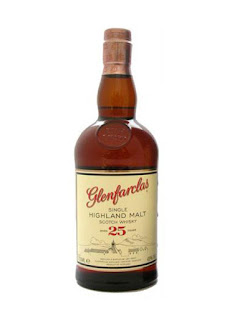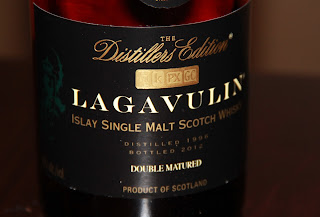January 26, 2013
Glenfarclas 25 Year - We'd Love to Love You Baby
We'd Love to Love You Baby
We'd love to love Glenfarclas. It's the kind of no frills whisky that turns us on. It comes in a smart bottle without a lot of nonsense. (Don't you sometimes feel like you're paying a few hundred bucks just for the bottle??) Glenfarclas is a Speyside distillery that's been doing their thing since the mid 1800's. Glenfarclas attributes it's success to fresh spring water from "the heather clad slopes of the 840 metre high Ben Rinnes mountain, purple in autumn and snow clad in winter," and "the unique size and shape of the Glenfarclas copper pot stills".
Speyside
Due to our obsession with Islay, we haven't yet featured a Speyside scotch. However, the majority of scotch actually comes from Speyside. Speyside is a region in the northeastern Scottish Highlands named for the areas surrounding the river Spey including Moray, Badenoch, and Strathspey. There are over 40 Speyside distilleries, making it the most prolific scotch producing region in the world. Most of the common malts that you'll find in bars come from Speyside like Macallan, Glenfiddich, and Glenlivet. There are also some real gems from the area like Balvenie, Aberlour, and Glenrothes.
Generally our hunt for smoky beasts keeps us away from Speyside. Their malts tend to be less peaty and certainly less beastly. Speyside malts were our first forays into scotch, back when Jack Daniels was SOP (standard operating procedure) and anything containing a 'Glen' was for special occasions. Once our tastes matured, we moved quickly towards Islay. Some people prefer Speyside. Evidently the argument is that peat smoke takes away from the fruity flavors of the whisky and masks some of the character. We don't agree, but "hey man it's your trip". So if you're a huge Speyside fan, you might want to discount our reviews and find a site more aligned to your particular sentiments.
Expectations
Ok, brass tacks: for over $150 per bottle, we're expecting to be blown away. Since we've showed countless examples of excellent scotch at well under $100/bottle, doubling these prices really should result in something special. We hate cutting right to the dollars and cents, but as your faithful narrators and guides through the wonderful world of whisky, sometimes we have to go ahead and break it down for you and your wallet, respectively. Glenfarclas 25-year is available from KLWines for $159.99 or from Amazon for $169.99. We don't expect a scotch that's twice as expensive to be twice as good. We appreciate, to some extent, the law of diminishing returns. But we're going to be tougher on something in this price range because, well, it's your dollar and you'd expect nothing less.
Tasting Notes
Nose: Surprisingly sharp, mostly alcohol with strong citrus flavors and some sweet honey.
Body: There's not a lot here. Some mild fruits, no peat or smoke, a little sweetness at the sides of the mouth, and some citrus and banana. Not very much depth. Pleasant, but not memorable.
Finish: Remains too sharp for it's age. It's missing the mellow full flavor we'd expect from a 25 year whisky. A little grape and honey on the aftertaste, but still too much of the alcoholic tinge to be in the class of our top choices.
Review
We're sad to give Glenfarclas 25 a "C", but at over $150/bottle, we want to be honest. Chalk it up to our preference for Islay over Spey, after all this is SmokyBeast! Far from masking the flavor of the scotch, in our experience, peat smoke masks only the alcoholic burn of the whisky which actually brings out all the little sweet and fruity notes. Our advice is to save your money. If you want to experience the brand, buy a bottle of the 12 Year. It's a third of the price. If you love that, move on to the 17 for around $100. If you're in love, then by all means plunk down for the 25, or throw caution to the wind and throw down $500 for the 40-Year. If you do that, let us know what you think, because we'll be sipping something with smoke!
If you're jones'ing to try some Speyside, there are other malts which achieve the smoothness we'd expect at this price. Try the Glenrothes 1988, or the Balvenie 17-Year Doublewood.
/SmokyBeast
We'd love to love Glenfarclas. It's the kind of no frills whisky that turns us on. It comes in a smart bottle without a lot of nonsense. (Don't you sometimes feel like you're paying a few hundred bucks just for the bottle??) Glenfarclas is a Speyside distillery that's been doing their thing since the mid 1800's. Glenfarclas attributes it's success to fresh spring water from "the heather clad slopes of the 840 metre high Ben Rinnes mountain, purple in autumn and snow clad in winter," and "the unique size and shape of the Glenfarclas copper pot stills".
Speyside
 |
| Speyside |
Generally our hunt for smoky beasts keeps us away from Speyside. Their malts tend to be less peaty and certainly less beastly. Speyside malts were our first forays into scotch, back when Jack Daniels was SOP (standard operating procedure) and anything containing a 'Glen' was for special occasions. Once our tastes matured, we moved quickly towards Islay. Some people prefer Speyside. Evidently the argument is that peat smoke takes away from the fruity flavors of the whisky and masks some of the character. We don't agree, but "hey man it's your trip". So if you're a huge Speyside fan, you might want to discount our reviews and find a site more aligned to your particular sentiments.
Expectations
Ok, brass tacks: for over $150 per bottle, we're expecting to be blown away. Since we've showed countless examples of excellent scotch at well under $100/bottle, doubling these prices really should result in something special. We hate cutting right to the dollars and cents, but as your faithful narrators and guides through the wonderful world of whisky, sometimes we have to go ahead and break it down for you and your wallet, respectively. Glenfarclas 25-year is available from KLWines for $159.99 or from Amazon for $169.99. We don't expect a scotch that's twice as expensive to be twice as good. We appreciate, to some extent, the law of diminishing returns. But we're going to be tougher on something in this price range because, well, it's your dollar and you'd expect nothing less.
Tasting Notes
Nose: Surprisingly sharp, mostly alcohol with strong citrus flavors and some sweet honey.
Body: There's not a lot here. Some mild fruits, no peat or smoke, a little sweetness at the sides of the mouth, and some citrus and banana. Not very much depth. Pleasant, but not memorable.
Finish: Remains too sharp for it's age. It's missing the mellow full flavor we'd expect from a 25 year whisky. A little grape and honey on the aftertaste, but still too much of the alcoholic tinge to be in the class of our top choices.
Review
We're sad to give Glenfarclas 25 a "C", but at over $150/bottle, we want to be honest. Chalk it up to our preference for Islay over Spey, after all this is SmokyBeast! Far from masking the flavor of the scotch, in our experience, peat smoke masks only the alcoholic burn of the whisky which actually brings out all the little sweet and fruity notes. Our advice is to save your money. If you want to experience the brand, buy a bottle of the 12 Year. It's a third of the price. If you love that, move on to the 17 for around $100. If you're in love, then by all means plunk down for the 25, or throw caution to the wind and throw down $500 for the 40-Year. If you do that, let us know what you think, because we'll be sipping something with smoke!
If you're jones'ing to try some Speyside, there are other malts which achieve the smoothness we'd expect at this price. Try the Glenrothes 1988, or the Balvenie 17-Year Doublewood.
/SmokyBeast













